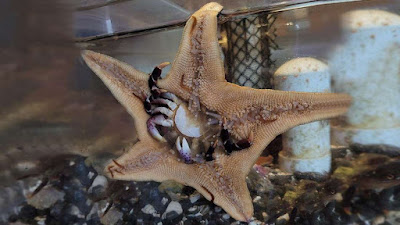Incredible Photo Reveals Grim Fate Of Bat Sea Star Victims
'YUP, THAT’S ME. YOU’RE PROBABLY WONDERING HOW I ENDED UP IN THIS SITUATION,' - UNFORTUNATE CRAB, 2020. IMAGE C
OURTESY OF GREG POTTER
By Rachael Funnell 29 OCT 2020, 17:00
Aquariums are a great source of education, scientific research, and conservation funding when done properly. These unique establishments enable people from all backgrounds to gain insight into the fascinating world that exists beneath the waves. They also enable us to see things we normally can't, in the most literal sense of the phrase, as the glass tanks that house the animals can offer us a sneak peek of what's happening underneath an animal’s body.
Greg Potter was visiting the Ucluelet Aquarium, a non-profit catch-and-release aquarium on the west coast of Vancouver Island, Canada, when he spotted something unusual happening in one of the tanks. A bat sea star had managed to snag a crab and, thanks to the tank-side view provided by the clear glass, could be seen digesting it.
“Apparently the crabs are stored in there waiting to be fed to a wolf eel but this sea star just saw an opportunity,” Potter, who is joining the Strawberry Isle Marine Research Society (SIMRS) as Science Communications Director next week, told IFLScience. “They don't aim to feed the sea stars live prey.”
Sea stars, also known as starfish, move using tiny tube feet, which can be seen on the underside of the bat sea star in the photo. These animals have a reputation for being a bit slow and lethargic (probably because of photos like this) but some are faster than you might expect. An adult sunflower sea star, as seen in the above video, can whiz across the ocean floor at a rate of 1 meter (3 feet) a minute thanks to the 15,000 tube feet that sit beneath its body. Sea stars also use these tube feet to grab onto and hold their prey, which would explain how the unfortunate crab found itself in this situation.
“If the star already had a leg up waving around (as they sometimes do) it wouldn't take much contact to get the crab as they're surprisingly strong,” said Potter. “In the wild, I saw one trying to eat a fried egg jellyfish it had caught but I don't know how that turned out.”
Once a sea star has a hold of its prey, it will expel its stomach out of its mouth and digests its food into a sort of chowder which is then slurped up into digestive glands. Evidently, the bat sea star in the photo had only just begun its meal but no doubt employees at the aquarium were treated to a live crab chowder demonstration for the rest of the day. Yummy...

No comments:
Post a Comment